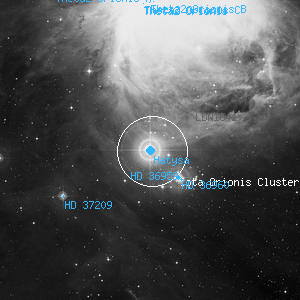Hatysa

Overlaid DSS image of Hatysa, 60' x 60' with north at top and west to the right
Aladin viewer for the region around Hatysa
Iota Orionis, ι Ori, 44 Ori
Σ 752, BD-06 1241, HD 37043, HR 1899, WDS J05354-0555A, SAO 132323, GSC 04778-01401, HIP 26241
Σ 752, BD-06 1241, HD 37043, HR 1899, WDS J05354-0555A, SAO 132323, GSC 04778-01401, HIP 26241
| Type | Star |
|---|---|
| Magnitude | 2.77 | Right Ascension | 5h 35' 26.0" (2000) |
| Declination | 5° 54' 36" S |
| Constellation | Orion |
| Classification | O9IIIvar |
Observing Notes
Andrew Cooper
Nov 27, 2020 Waikoloa, HI (map)
20cm f/6 Newtonian, Cave Astrola @ 136x
Seeing: 5 Transparency: 6 Moon: 90%
Brilliant blue-white, surrounded by the soft glow of nebulosity and defining the center of the open cluster NGC 1980, two companions are easily visible, an 8th magnitude companion is seen 12" southeast and a 10th magnitude 50" east, the pretty double HR 1887/HR 1886 is 8' southwest, the southern margin of M42 intrudes on the northern edge of the field, overall the field is simply superb with the glow of nebulosity scattered with half a dozen 6 to 8th magnitude stars.
Captain William Henry Smyth
Feb 17, 1832 No. 6 The Crescent, Bedford, England (map)
150mm f/17.6 refractor by Tully 1827
A fine triple star, in a good field on Orion's sword-scabbard; and 5° south of the middle star in the belt. A 3½, white; B 8½, pale blue; and C 11, grape red. Piazzi says of ι, in his Notæ, "Duplex: comes 0".4 temporis sequitur, et vix distingui potest," —but his instrument being fully equal to distinguish such a magnitude as that of B, his remark excites a suspicion that it may be variable. There is a glow about this object, when viewed under favouring circumstances; yet I cannot assert that the nebulosity in which it is enveloped, is clearly seen. But under proper means it is well worth scrutiny; for nebulous stars are certainly among the most remarkable objects in the heavens, and perhaps should be distinguished from stellar nebulæ in being of a less doubtful character, as to the state of condensation, the central matter in such being suddenly vivid, and sharply defined. ι Orionis is 12 ♅. III., and was thus measured when first classed:
AB Pos. 133°51' Dis. 12".50 Ep. 1779.77
AC 101°19' 48".31
[AB 141° 11".2 2021 WDS
AC 103° 49".4 2002 WDS]
When Sir James South re-examined this star, in 1824, A and B were considered, from the apparent change of angle in fifty-five years, to have a direct orbital motion = + 0"'202 per annum; but more recent observations do not support the inference. The measures with which I compared mine, are:
S. Pos. 141°58' Dist. 12".08 Ep. 1824.74
D. 141°21' 11".89 1831.16
Σ. 142°10' ll".32 1831.86
[WDS 141° 11".2 2021 ]
* Since my observations were made, a sixth star has been seen just outside A, nearly in the line with A and B. But it is a very intensiva of vision, and therefore quite escaped me. The Rev. W. R. Dawes managed to measure it, and he kindly communicated to me the following results:
Mean of 6 Observations of Pos. = 127°48' Ep. 1842.16
4 Dis. = 2".79
"My attention," he writes, "was directed to this star by Mr. W. Lassell, Jun., of Star-field. He lately saw the small companion with a newly-figured 9-inch Newtonian metal, of 112 inches focus, made by himself."― A Cycle of Celestial Objects Vol II, The Bedford Catalogue, William Henry Smyth, 1844
Other Data Sources for Hatysa
Nearby objects for Hatysa
23 objects found within 60'
Credits...
Drawings, descriptions, and CCD photos are copyright Andrew Cooper unless otherwise noted, no usage without permission.
A complete list of credits and sources can be found on the about page
Hatysa